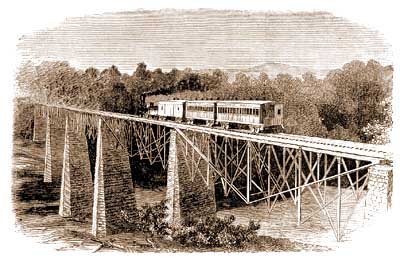The Preserve > L&N Railroad Bridge
OFFICIAL RECORDS.
VOL 52 Pt. 2 P. 152
Bowling Green. Sept. 19, 1861
Gen A. S. Johnston:
Are my orders imperative to
destroy the Green River Bridge
immediately, and to withdraw my
advanced forces at once? I have
made arrangements to do so.
Unless the military necessity is great, the destruction of so fine a work would injure us very much politically. Hawes has rallied about 300 Southern men from Barren and 100 from Hardin Counties. Hawes reports Rousseau with 1,700 men on Muldraugh's Hilll, probably at the mouth of Salt River.
S. B. Buckner. Brigadier General.
The Louisville-Nashville Railroad Bridge, constructed in 1857-1859 as part of the Louisville-Nashville Railway System, spans the Green River and is still used by trains of the current CSX system in its reconstructed form. During the construction of the L&N railroad, the Green River presented a formidable obstacle that had to be surmounted. A well-known construction engineer from Germany, Albert Fink, was hired to design and supervise the construction of a massive structure over the Green River. He planned to support the tracks and all trains over this bridge by constructing an elaborate trusswork of his own design supported by four enormous and intricately detailed stone piers. John W. Key of Woodsonville and his two sons, Abner David Lewis Key and John Martin Key, all stonemasons, were hired to construct the piers.
In October 1861, General Simon Bolivar Buckner of the C.S.A. received orders to destroy the bridge to prevent Federal troops from crossing. That the bridge was an engineering marvel and had been built by local workers and craftsmen from his hometown compelled Buckner to protest this action, but to no avail. John Key and his two sons were ordered to place explosive charges in the two southernmost piers. They detonated the charge in the southernmost pier, dropping two spans of the bridge into the river 125 feet below.
There is no record of the Keys' reaction to being ordered to destroy their own masterpiece, but one might well imagine their feelings. Noting that the bridge was extensively damaged and would be out of commission for some time, Buckner refused to order the second charge blown. Concerned citizens later removed the explosives from the pier.
There is nothing left of the original "Fink Truss," but the Keys' stonework still remains as a physical reminder of what once was.
|
|



 |

